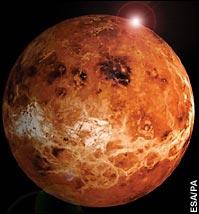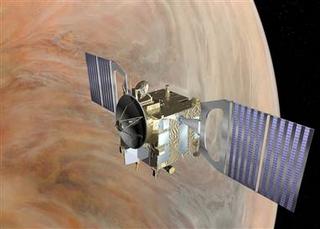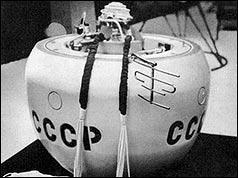

The Europeans are sending a probe into Venus for a price ticket of US$240Million.
One of the mysteries the mission is trying to solve is why Venus is so hot. Advanced instruments onboard will peer beneath the thick cloudy atmosphere to find out if volcanoes are to blame. Venus Express will also explore the giant hurricanes that sweep the planet’s surface.
A British-build magnetometer will look at the interaction between the planet’s weak magnetic field and the solar wind, a torrent of electrically charged particles that stream from the sun.
Imperial College space scientist Chris Carr said Earth's magnetic field deflects solar-wind particles so that they don't "cause us any trouble to speak of."
"If you’re at Venus, you have no protecting magnetic field, and this million-mile-an-hour stream of ionization radiation slams straight into the upper atmosphere of the planet,” Carr told reporters.
Understanding this interaction could be of more than just academic interest. Some scientists warn that future climate change could make Earth more like Venus.
“We’re struggling to understand the Earth’s climate, and in particular how it will change," Taylor said. "And it is in fact changing in the direction towards being more like Venus, more CO2 (carbon dioxide) in the atmosphere, higher temperatures. I’m not saying the Earth will ever become as extreme as Venus, but it’s moving in that direction."
The results of the Venus Express mission could "help us to plan our own future and understand it," Taylor said, and perhaps even suggest new ways to avoid the worst-case scenarios for climate change.
The way I see it, she's hot because she's a babe... err... maybe not. Just kidding :)

Of course, the Russians have sent a probe to Venus in the mighty Soviet days:

After its four-month journey from Earth, Venera 4 plunged through the planet's dense cloud cover and down towards the surface.
Almost immediately it began sending back coded bleeps carrying details of the gases that make up the air around Venus, as well as readings for temperatures and pressure.
It is the first time any measurements have been taken from inside the planet's atmosphere.
The Soviet Union had hoped to attempt a "soft" landing on the surface of Venus, and Venera 4 carried equipment designed to allow communications even while submerged beneath any oceans which it was suspected there might be on the surface.
But contact was lost 94 minutes after the probe entered the atmosphere, when it would still have been about 15 miles (25 km) above the planet itself.
Space cooperation
The signals sent back from Venera 4 were picked up by the radio telescope at Jodrell Bank in Cheshire.
The observatory was invited to take part in the mission to Venus by the Soviet Academy of Scientists.
The director of Jodrell Bank, Professor Sir Bernard Lovell, said the radio signals sent back from Venera 4 confirmed that it was unlikely and almost impossible that there was life on the planet.
At a news conference, Professor Lovell said Jodrell Bank was delighted to help the Soviet Union in tracking the spacecraft.
"This appears ... as a rational common-sense attitude, the sort of thing one always hopes will emerge in these colossal, expensive space enterprises," he said.
Venera 4 is the first successful attempt to reach Venus after three failed Soviet missions.
Venera 3 came closest, and successfully reached the planet, but communications had already failed, making the mission a failure.
Within the next few days, the American spacecraft Mariner 5 is also expected to arrive at Venus.
It is not, however, planning to attempt a landing, but will fly past at about 2,500 miles (4,000 km) from the planet while instruments on board measure the atmosphere and magnetic fields.
A previous American mission, Mariner 2, was the first to fly by Venus and scan its features in December 1962.
Data sent back from that mission suggested that Venus has hot surface temperatures and an atmosphere dominated by carbon dioxide.
The word is that knowing Venus could help with understanding our own issues of Global Warming:
Scientists involved in the £140m mission said that studying the extreme environment of Venus, which has been called Earth's "evil twin", will help climate researchers to make better predictions about global warming caused by changes to our own atmosphere.
Venus, the second planet from the Sun and the closest neighbour to Earth, is one of the least understood bodies in the solar system, primarily because it is shrouded in dense, impenetrable clouds of sulphuric acid. Venus was formed at the same time as the Earth and from the same sort of material. It is also about the same size, mass and density. However, Venus is a searing hot place with average temperatures hovering around 464C, about 400C higher than they should be because an intense Venusian greenhouse effect traps the Sun's energy before it can be reflected from the planet's surface back into space.
Professor Fred Taylor of Oxford University, who first proposed the mission to Venus, said that Venus had long been an object of fascination and mythology. "The human race has been studying Venus since the beginning of time because it's far the brightest object in the sky," he said.
Yet despite the many reasons for believing that Venus is the twin planet of Earth, scientists are still not sure about the precise reasons why the two planets differ so widely in their respective greenhouse effects.
And so it goes.

No comments:
Post a Comment